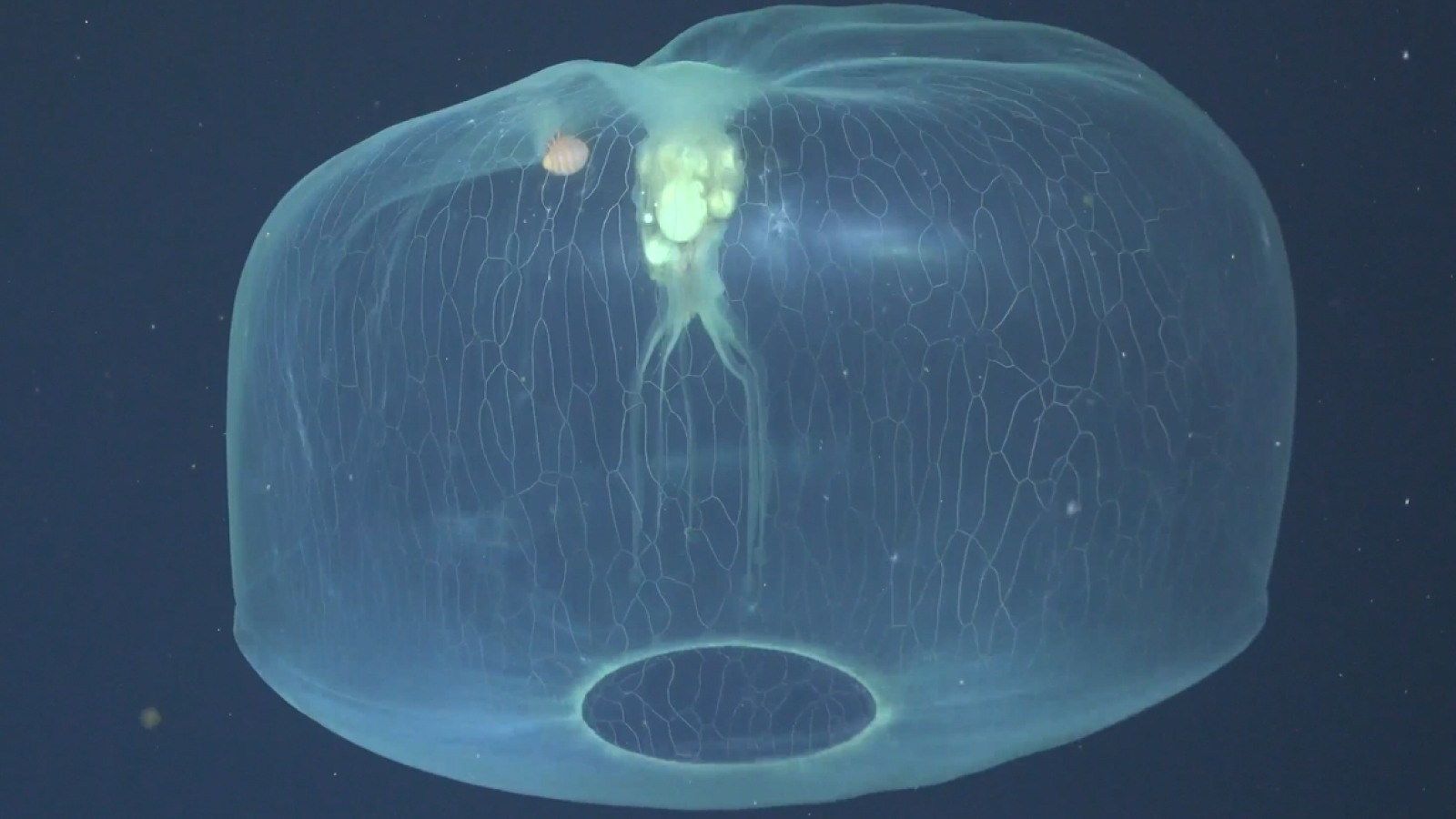
Eerie new footage captures a rare, otherworldly scene: a giant jellyfish with a tiny isopod swimming around in its bag-like body. In the video, the translucent blob contracts its veiny membrane as it floats in the twilight zone with the bright-orange isopod, a type of crustacean, inside its bell.
Scientists with the Schmidt Ocean Institute spotted the elusive creature at a depth of 2,766 feet (843 meters) during an expedition to the Atacama Trench off the coast of Chile. They identified the jellyfish as belonging to the genus Deepstaria. These jellyfish lack long, stinging tentacles, so they capture their dinner by enveloping prey within their bodies, according to an Instagram post from the institute. The isopod in the video, however, isn't prey: Rather, it is a permanent resident.
Deepstaria jellyfish were first discovered off the California coast in 1966 and were named after Deepstar 4000, the submersible that spotted them. Since then, Deepstaria sightings have been extraordinarily rare.

There are currently two recognized species within this genus: Deepstaria enigmatica and Deepstaria reticulum.
Their exact distribution remains unknown but both species have been found in the Gulf of Mexico, off the coast of California, Caribbean and Central Atlantic Ocean. D. enigmatica has also been observed in the Southern Ocean near the Antarctic. All observations were recorded at depths of around 2,000 to 5,700 feet (600 to 1,750 m), according to a 2018 study.
Related: Alien-like giant phantom jellyfish spotted in frigid waters off Antarctica
Deepstaria jellyfish use their membranous bell to engulf small crustaceans, fish and even other jellyfish, closing their bell to keep prey trapped inside. This motion allows isopods to enter the body of the jellyfish.
The footage reveals the veiny network of the gastrovascular system on its body, which is important for digesting and delivering food to the stomach at the top of the animal's bell, according to the post.
"We are seeing a large scyphozoan jellyfish called Deepstaria enigmatica which belongs to the family Ulmaridae, the same family as the common moon jellyfish," said Allen Collins, curator of Porifera, Medusozoa and Ctenophora at the Smithsonian's National Museum of Natural History, who was not on the expedition.
"On the underside of the subumbrella (up inside the bell) we can see an isopod, Anuropus bathypelagicus that is often (always perhaps) associated with this jelly," Collins told Live Science in an email.
A. bathypelagicus is a large, blind isopod that can grow to more than 3 inches (8 centimeters) long. Researchers have spotted Anuropus living in both species of Deepstaria and using hooked appendages to grip onto their bodies.
In 1969, a study using the Deepstar submersible reported observations of D. enigmatica with abnormal, almost motionless swimming movements. As the submersible moved, the wave of water flipped the jellyfish on its side, revealing a small Anuropus isopod clinging to its body.
When examined, the jellyfish was missing body parts, including its stomach and the lining of its body, which explained its flaccid behavior and led to suspicions that the isopod might be feeding on the jellyfish. Jellyfish remains have also been found in the stomach contents of A. bathypelagicus, which further supports the notion that the isopod eats its Deepstaria host, Collins said.
However, this could also suggest that the isopod feeds on the captured prey within the Deepstaria.
"Just a handful of papers have mentioned it and no one specifically has traced the isopod actually eating the Deepstaria host," Collins explained.
As the jellyfish floats in the water column, the isopod may benefit by using the giant blob as a vehicle and protection from predators. "The isopod is blind and likely benefits by getting a ride on the jellyfish and perhaps a safer place to hide," Collins said. What, if anything, Deepstaria gets out of the relationship is unclear.







